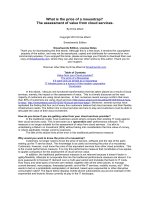Marketing CH13a building the price foundation
Bạn đang xem bản rút gọn của tài liệu. Xem và tải ngay bản đầy đủ của tài liệu tại đây (2.09 MB, 54 trang )
McGraw-Hill/Irwin
Copyright © 2009 by The McGraw-Hill Companies, Inc. All Rights Rese
LEARNING OBJECTIVES (LO)
AFTER READING CHAPTER 13, YOU SHOULD BE ABLE TO:
LO1
LO2
LO3
Identify the elements that make up a
price.
Recognize the objectives a firm has in
setting prices and the constraints that
restrict the range of prices a firm can
charge.
Explain what a demand curve is and
the role of revenues in pricing
decisions.
13-2
LEARNING OBJECTIVES (LO)
AFTER READING CHAPTER 13, YOU SHOULD BE ABLE TO:
LO4
Describe what price elasticity of
demand means to a manager facing a
pricing decision.
LO5
Explain the role of costs in pricing
decisions.
LO6
Describe how various combinations of
price, fixed cost, and unit variable cost
affect a firm’s breakeven point.
13-3
LO1
NATURE AND IMPORTANCE OF PRICE
WHAT IS A PRICE?
Price
Barter
Price Equation
Final Price = list Price – (Incentives + Allowances) + Extra Fees
13-6
FIGURE 13-2 The “price” a buyer pays can
take different names depending on what is
purchased
13-7
LO1
NATURE AND IMPORTANCE OF PRICE
PRICE AS AN INDICATOR OF VALUE
Value
Value =
Perceived Benefits
Price
$
=
$
Value-Pricing
13-8
LO1
NATURE AND IMPORTANCE OF PRICE
PRICE IN THE MARKETING MIX
Profit Equation
Profit = Total Revenue – Total Costs
= (Unit Price x Quantity Sold) – (Fixed Cost + Variable Cost)
Six Steps in Setting Price
13-9
FIGURE 13-3 The six steps in setting price.
The first three steps are covered in Chapter
13 and the last three steps in Chapter 14.
13-10
STEP 1: IDENTIFY PRICING OBJECTIVES
LO2
AND CONSTRAINTS
IDENTIFYING PRICING OBJECTIVES
Pricing Objectives
• Profit
Managing for Long-Run Profits
Managing for Current Profit
Target Return (ROI)
• “The World is Flattening”
13-11
STEP 1: IDENTIFY PRICING OBJECTIVES
LO2
AND CONSTRAINTS
IDENTIFYING PRICING OBJECTIVES
Pricing Objectives
• Sales ($)
• Survival
• Market Share ($ or #)
• Social
Responsibility
• Unit Volume (#)
13-13
STEP 1: IDENTIFY PRICING OBJECTIVES
LO2
AND CONSTRAINTS
IDENTIFYING PRICING CONSTRAINTS
Pricing Constraints
• Demand for the
Product Class (Cars),
Product (Sports Cars),
and Brand (Bugatti Veyron)
• Newness of the
Product: Stage in the
Product Life Cycle
eBay
13-14
STEP 1: IDENTIFY PRICING OBJECTIVES
LO2
AND CONSTRAINTS
IDENTIFYING PRICING CONSTRAINTS
• Single Product vs.
a Product Line
• Cost of Producing and
Marketing a Product
• Cost of Changing
Prices and Time Period
They Apply
13-15
STEP 1: IDENTIFY PRICING OBJECTIVES
LO2
AND CONSTRAINTS
IDENTIFYING PRICING CONSTRAINTS
• Type of Competitive Market
Pure Competition
Monopolistic Competition
Oligopoly
Pure Monopoly
• Competitors’ Prices
13-16
FIGURE 13-4 Pricing, product, and
advertising strategies available to firms in
four types of competitive markets
13-17
LO3
STEP 2: ESTIMATE DEMAND
AND REVENUE
FUNDAMENTALS OF ESTIMATING DEMAND
• The Demand Curve
Consumer Tastes
Price and Availability
of Similar Products
Consumer Income
• Demand Factors
13-18
LO3
STEP 2: ESTIMATE DEMAND
AND REVENUE
FUNDAMENTALS OF ESTIMATING DEMAND
• Movement Along vs. a
Shift of Demand Curve
Movement Along
a Demand Curve
Shift in the
Demand Curve
13-20
FIGURE 13-5A Demand curve for Newsweek
showing the effect on annual sales by a
change in price caused by a movement
along the demand curve
13-21
FIGURE 13-5B Demand curve for Newsweek
showing the effect on annual sales by a
change in price caused by a shift of the
demand curve
13-22
LO3
STEP 2: ESTIMATE DEMAND
AND REVENUE
FUNDAMENTALS OF ESTIMATING REVENUE
Total Revenue (TR)
Average Revenue (AR)
Demand Curves
and Revenue
13-23
MARKETING MATTERS
The Airbus vs. Boeing Face-off—How Many Can We Sell
and at What Price…in a $2.7 Trillion Market?
The Products
Marketing
and Pricing
Demand
13-25
LO4
STEP 2: ESTIMATE DEMAND
AND REVENUE
FUNDAMENTALS OF ESTIMATING REVENUE
Price Elasticity of Demand
Price Elasticity of Demand (E) =
Percentage Change in Quantity Demanded
Percentage Change in Price
• Elastic Demand
• Inelastic Demand
• Unitary Demand
13-26
LO4
STEP 2: ESTIMATE DEMAND
AND REVENUE
FUNDAMENTALS OF ESTIMATING REVENUE
Price Elasticity of Demand
• Product Substitutes
• Necessities
• Large Cash Outlays
13-27
Clothing and Gasoline
Which product is more sensitive to price changes?
13-28
LO5
STEP 3: DETERMINE COST, VOLUME,
AND PROFIT RELATIONSHIPS
THE IMPORTANCE OF CONTROLLING COSTS
Total Cost (TC)
Fixed Cost (FC)
Variable Cost (VC)
Unit Variable Cost (UVC)
Marginal Cost (MC)
Marginal Analysis
13-29
FIGURE 13-8 Fundamental cost concepts
13-30









